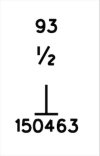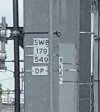Another point to consider (and I have to on a daily basis) - mileposts, quarters, half and three quarters on the track can be notoriously inaccurate
It’s been known by long serving track workers that many of these are somewhat out of position. In places where the chainage is still painted on the rails, it’s not uncommon for the chain mark to be different to the nearby post…
Also re the use of chains - a lot of the old NR / BR records are in miles & chains.
In a lot of areas where there has been no recent infrastructure investment, most records and documentation will be in miles & chains, or miles & yards. Sometimes in feet as well.
Existing signalling and telecommunications cable lengths are listed in yards. Although new cables are now measured and listed in metres.
There are also discrepancies between different sets of records. Including the mileage & chainage where the ELR (Engineers Line Reference) changes on what is now ‘plain line’!
"Is it an urban myth or did it really happen" No.97: in the 1970s BR wanted to embrace modern Continental-style metrication and eliminate old-fashioned miles, furlongs and chains. The Western Region main line was chosen for a pilot project and kilometre posts were installed from the buffer-stops at Paddington all the way to those at Penzance. It took a lot of surveying, a long time and considerable expense. However, just as the final post was put in place on the approach to Penzance, it was decided to extend the Lawn at Paddington by a few metres and the buffer-stops were duly moved a few metres west. This at a stroke rendered all the new posts inaccurate. Shortly afterward the whole scheme was quietly dropped. At least, that's what a fellow-railwayman told me in a pub once. Can anyone corroborate this sad story?
Sounds like a nice yarn that the person in the pub spun for you.
I’ve seen absolutely no sign of any kilometre posts lineside or any references in any BR 1970s or later documentation. Parts of the Western Region have never even moved the mile posts, quarter, half and three quarter posts from the downside to the upside (normal practice is to have them on the up side, but on some lines, due to historical reasons they are on the downside) or replaced the non-Western type with Western types or the current style.
Until the TVSC signalling scheme, I had never seen km used on the railway in my area. GWML ATP has however used metric metres for the distances and positions of the beacons and of the length of the infill loops. And the dimensions of various signalling equipment, allowable tolerances, specifications, checking gauges have been metric for many, many years.
Now all the TVSC signalling plans for my area all use metres for the distance and location measurements. Mile posts, quarter, half and three quarter posts are however still shown. Each has their location shown in metres below them. Like this:

Nearly everything else is in metric on these plans.
So, I often find myself converting between metres and imperial.


